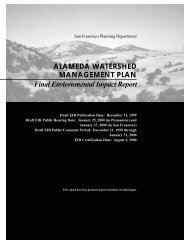Feasibility of Fish Passage at Alameda Creek Diversion Dam
Feasibility of Fish Passage at Alameda Creek Diversion Dam
Feasibility of Fish Passage at Alameda Creek Diversion Dam
You also want an ePaper? Increase the reach of your titles
YUMPU automatically turns print PDFs into web optimized ePapers that Google loves.
<strong>Feasibility</strong> <strong>of</strong> <strong>Fish</strong> <strong>Passage</strong> <strong>at</strong> <strong>Alameda</strong> <strong>Creek</strong> <strong>Diversion</strong> <strong>Dam</strong><strong>Alameda</strong> <strong>Creek</strong> W<strong>at</strong>ershed has been modified extensively for purposes <strong>of</strong> flood control and w<strong>at</strong>ersupply, and contains three major reservoirs (Calaveras, San Antonio, and Del Valle). The Lowerreaches <strong>of</strong> <strong>Alameda</strong> <strong>Creek</strong> near Fremont have been modified extensively for flood control and w<strong>at</strong>ersupply. Roughly 3,000,000 residents <strong>of</strong> the Bay Area rely on <strong>Alameda</strong> <strong>Creek</strong> for clean drinkingw<strong>at</strong>er (SFEI, 2009). In addition to being managed for the growing urban area <strong>of</strong> Livermore, Dublin,Pleasanton, and Fremont, the w<strong>at</strong>ershed is managed for grazing, equestrian facilities, nurseries, and,more recently, vineyards.<strong>Alameda</strong> <strong>Creek</strong> W<strong>at</strong>ershed is composed <strong>of</strong> three sub-w<strong>at</strong>ersheds (Figure 1-1; Table 2-1). The largestsub-w<strong>at</strong>ershed is the Arroyo de la Laguna Sub-W<strong>at</strong>ershed, which <strong>at</strong> approxim<strong>at</strong>ely 270,000 acresdrains more than 60 percent <strong>of</strong> the total w<strong>at</strong>ershed and contains the major reservoir, Lake Del Valle.The Arroyo de la Laguna Sub-W<strong>at</strong>ershed would not be directly influenced by fish passage <strong>at</strong> ACDD.The Upper <strong>Alameda</strong> <strong>Creek</strong> Sub-W<strong>at</strong>ershed is the second largest <strong>of</strong> the three sub-w<strong>at</strong>ersheds, which <strong>at</strong>approxim<strong>at</strong>ely 130,000 acres drains just less than 30 percent <strong>of</strong> <strong>Alameda</strong> <strong>Creek</strong> W<strong>at</strong>ershed. TheUpper <strong>Alameda</strong> <strong>Creek</strong> Sub-W<strong>at</strong>ershed contains the ACDD and ACDT, the subject <strong>of</strong> this fish passagetechnical memorandum, and it also contains Calaveras and San Antonio reservoirs (Figure 1-1).The Lower <strong>Alameda</strong> <strong>Creek</strong> Sub-W<strong>at</strong>ershed is the smallest sub-w<strong>at</strong>ershed; it drains the lower area <strong>of</strong>approxim<strong>at</strong>ely 40,000 acres, or 10 percent <strong>of</strong> the area <strong>of</strong> the entire <strong>Alameda</strong> <strong>Creek</strong> W<strong>at</strong>ershed.2.2 UPPER ALAMEDA CREEK SUB-WATERSHEDThe ACDD and ACDT are loc<strong>at</strong>ed in the approxim<strong>at</strong>ely 26,000-acre Upper <strong>Alameda</strong> <strong>Creek</strong> Basin,which is the second largest <strong>of</strong> five basins in the Upper <strong>Alameda</strong> <strong>Creek</strong> Sub-W<strong>at</strong>ershed (Figure 1-1;Table 2-1). <strong>Alameda</strong> <strong>Creek</strong> is the main stream draining the Upper <strong>Alameda</strong> <strong>Creek</strong> Basin. Despitebeing the namesake <strong>of</strong> the entire <strong>Alameda</strong> <strong>Creek</strong> W<strong>at</strong>ershed, this portion <strong>of</strong> <strong>Alameda</strong> <strong>Creek</strong> typicallydoes not have perennial flow, but r<strong>at</strong>her is an intermittent stream th<strong>at</strong> dries to a series <strong>of</strong> isol<strong>at</strong>ed poolsand sections <strong>of</strong> wetted channel during the dry season (Hagar and Paine, 2008).Wet season flows from the Upper <strong>Alameda</strong> <strong>Creek</strong> Basin are diverted via the ACDT to CalaverasReservoir, loc<strong>at</strong>ed <strong>at</strong> the confluence <strong>of</strong> Calaveras <strong>Creek</strong> and Arroyo Hondo basins. Calaveras <strong>Creek</strong>,an intermittent stream, drains the Calaveras Basin. It is the smallest basin in the sub-w<strong>at</strong>ershed,consisting <strong>of</strong> approxim<strong>at</strong>ely 13,000 acres. Arroyo Hondo, a perennial stream, drains theapproxim<strong>at</strong>ely 51,000-acre Arroyo Hondo Basin, the largest basin in the sub-w<strong>at</strong>ershed.The Upper <strong>Alameda</strong> <strong>Creek</strong> Sub-W<strong>at</strong>ershed also contains the approxim<strong>at</strong>ely 25,000-acre San AntonioBasin, which drains into San Antonio Reservoir, and the approxim<strong>at</strong>ely 15,000-acre Mid-<strong>Alameda</strong><strong>Creek</strong> Basin, which is below both the Calaveras and San Antonio reservoirs (Figure 1-1; Table 2-1).2.3 STUDY AREAThe focus <strong>of</strong> this technical memorandum is to evalu<strong>at</strong>e the feasibility and benefit <strong>of</strong> providing fishpassage <strong>at</strong> the ACDD (specifically steelhead, see Section 2.5). Though completion <strong>of</strong> habit<strong>at</strong> surveyson SFPUC and non-SFPUC properties above ACDD were not within this scope <strong>of</strong> work, <strong>of</strong> directrelevance to this technical memorandum are the streams and facilities th<strong>at</strong> could be directlyinfluenced by fish passage <strong>at</strong> ACDD, all <strong>of</strong> which lie upstream <strong>of</strong> <strong>Alameda</strong> <strong>Creek</strong>’s confluence withCalaveras <strong>Creek</strong>, within the Upper <strong>Alameda</strong> <strong>Creek</strong> Basin.ACDD <strong>Passage</strong> June 2009 Page 2-2








